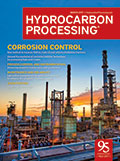
March 2017
Special Focus: Corrosion Control
Many refiners look at discounted opportunity crudes as a way to improve their margin spread. The growing varieties of discounted opportunity crudes on the market contain certain risks for the purchaser, such as high naphthenic acid or sulfur content.
For corrosion risk assessment and control, ample published research exists on the inherent corrosivity of combinations of naphthenic acid and sulfur in refining systems, but not on the chemistry and mechanism of corrosion inhibitors. This work offers refinery engineers insight into the construction of corrosion inhibitor molecules, as well as how differences in molecules impact the performance of the inhibitor and the risk of fouling in crude units and hydroprocessing units.
One of the major challenges in the oil and gas processing industry is to strike a balance among handling the changing qualities of petroleum products and byproducts, increasing the productivity and service life of critical components and reducing environmental hazards. As an example, new refineries are moving to applying conversion methods, such as hydrocracking, to increase yields, while also utilizing conventional distillation. This juxtaposition translates into a higher Nelson Index rating. Greater refinery complexity makes processing low-quality crude oil difficult, if not impossible, thereby precluding bottom-of-the-barrel products.
Maintenance and Reliability
Rolling bearings must be adequately lubricated to operate reliably and to prevent direct metal-to-metal contact between rolling elements, raceways, cages and other components. The choice of a suitable lubricant and lubrication method, and controlling contaminants, are important for improving the reliability of the machinery where these bearings are used.
One of the primary means for refiners to boost profitability is to improve crude diet flexibility. Many refiners are challenged with increasing their margins while the quality of the global crude oil supply declines.
The drop in crude oil prices since 2014 has impacted both upstream producers and downstream players. Upstream producers—those responsible for exploration, drilling and production—were the first to feel the effects. While refining margins benefitted from the drop in crude oil pricing, they began to suffer when record surpluses of gasoline and diesel flooded the market a year later.
Process Control and Instrumentation
Predicting the state of the energy industry a year or two from now is difficult. At best, potential scenarios can be envisioned, as in the International Energy Agency’s (IEA) World Energy Outlook 2016. Through this analysis of data and market reports, the IEA casts its projections for different scenarios to the year 2040. The IEA expects the fastest growth to occur in renewable energy, given recent climate pledges by global governments.
Fluid Flow and Rotating Equipment
All plants have a vibration monitoring program for rotating equipment. Portable instruments measure vibration at the bearing housing of machines at horizontal (x), vertical (y) and axial (z) directions. The frequency spectrum helps diagnose the causes of vibration.
Environment and Safety
For many sour gas streams present in a flare header, less expensive options than flare gas recovery may exist. The compressors, liquids management, downstream treating and other systems required for flare gas recovery (FGR) can be expensive to install and/or operate reliably. Some refineries allow the flaring of sweet gases.
According to the Roman philosopher Seneca, “Luck is what happens when preparation meets opportunity.” The reverse also is true, particularly in the context of safety in the process industry.
Show Previews
Gastech is the largest and most important business and technology event for the natural gas and LNG sector, creating a global platform to address and discuss the latest challenges faced in Asia and on a wider international scale.
Gulf Publishing Company and Hydrocarbon Processing are pleased to announce that IRPC 2017 will be held April 18–20 in New Delhi.
Columns
Preventing corrosion begins with the choice of materials and methods used to fabricate the equipment, piping, valves and instruments that will be exposed to varying process conditions and weather. At present, designers and fabricators can select from a multitude of modern materials and methods. Once in service, effective asset integrity programs will use smart condition monitoring and, where needed, a treatment regime to sustain the useful working life of all components. In the Special Focus section of this issue, we provide several articles that illustrate good practices in vessel fabrication, corrosivity analysis and corrosion prevention treatment.
Reliability improvement trends can be observed by paying close attention to conference presentations. Many conferences make it their goal to inform and update attendees on lubrication strategies.
When you are involved with a major failure and find yourself staring at pieces of debris scattered all over the area, it can be easy to become overwhelmed.
With job cuts numbering in the hundreds of thousands, the oil and gas industry has been hard-hit by the massive drop in prices. While no immediate end to the crisis is in sight, there are signs that prices—and hiring—may pick up again later this year.
Trends and Resources
The global petrochemical sector will continue to see strong growth through the end of the decade, despite a decrease in new project announcements. The crash in energy markets has shifted the industry’s mindset from bullish to optimistic.
Over the past decade, Africa’s oil demand has increased by more than 1 MMbpd, to nearly 3.9 MMbpd. Africa’s oil production is more than double the amount it consumes, but lack of investment, failing infrastructure and inadequate refining capacity force the continent to rely on imports to satisfy increasing fuel demand.
The European market saw stronger domestic demand amid gasoline export opportunities to West Africa and higher volumes of naphtha and fuel oil to Asia, fed by continued strong demand in that region. After recovery from the impact of the Colonial Pipeline outage, US refinery runs have risen, mainly in the USGC, taking advantage of stronger export opportunities and ahead of the spring maintenance season.
According to <i>Hydrocarbon Processing’s</i> Construction Boxscore Database, more than $400 B is being invested in active petrochemical projects around the world.
The major cause of premature bearing failure is lubrication related. A program utilizing ultrasound assisted lubrication can improve bearing life and prevent premature bearing failure.
Linde Engineering North America (LENA) has appointed Jason Cooper as President and CEO.

- China's Wanhua Chemical starts operation at new east China cracker 4/4
- Brookfield Infrastructure announces the acquisition of Colonial Enterprises for $9 B 4/4
- PBF restarts some units at Martinez refinery after February fire; fire-damaged units remain shut 4/4
- Japan to curb gasoline prices from June to cushion U.S. tariff blow 4/4
- Evonik presents innovative "Debonding on Demand" concept for more sustainable bonding 4/3
- Oil, gas and refined product imports exempted from Trump’s sweeping tariffs 4/3




